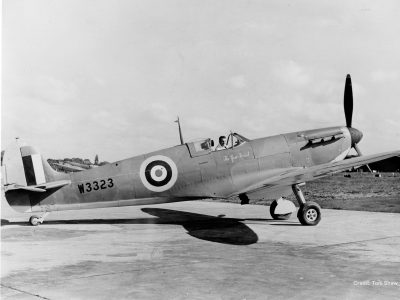A New Forest Spitfire
This picture shows James Shaw sitting in a Vickers Supermarine Spitfire at Eastleigh Airport.
The Spitfire is called the New Forest.
Throughout the Second World War, the British people were encouraged to save money and invest it in the war effort. National Savings campaigns on service themes were organised each year and local newspapers were full of advertising for them and their associated publicity events.
Special drives with various local activities were organised annually in the war years starting with the National Savings Week of June 1940 and followed by War Weapons Week, Warships Week, Wings for Victory, Salute the Soldier and Thanksgiving Week in subsequent years.
The Spitfire funds of 1940 represented tangible evidence for the support of the RAF by the British public. At that time enemy aircraft ranged over the skies of Southern Britain and with RAF planes flying from many Hampshire airfields, many local residents would have been familiar with the efforts of the young allied pilots. The bombing of Southampton, Portsmouth and many other places, combined with the crashes of numerous hostile aircraft, would have re-inforced the desirability of more fighters.
The idea of presenting planes had begun in the First World War and in the Summer of 1940 every other Spitfire off the production line had been donated. A nominal sum of £5,000 had been quoted as the cost of a Spitfire and in addition to individuals who provided a plane, local funds were started up all over the country and indeed the Commonwealth. However presenting an aircraft was in fact a nominal term as no additional planes were built. It was not possible to order individual aircraft as the factories were already in full production on Government contracts.
In Hampshire the campaign seems to have been launched following a letter from Dr HM King, a teacher at Taunton’s School in Southampton (later an MP and Speaker of the House of Commons), in the Hampshire Chronicle on 27 July 1940. The next edition of the weekly paper included an appeal to farmers, farm workers and everyone interested in the countryside for a Hampshire Agricultural Fighter Plane.
On 10 August the Mayor of Winchester opened an appeal for Winchester and District. Dr King wrote again the following week reporting that “a countywide campaign was springing up in Hampshire to raise Spitfires for the nation. Portsmouth was first in the field with two, Gosport, New Forest and Winchester are raising one (Is this the one in the picture?), Bournemouth and Southampton were stirring and Eastleigh would shortly be at work”.
There was even a campaign by a Cedarwood Pug-owning resident of Itchen Abbas who started an “Our dogs Dog Fighter Fund” to present a Spitfire from the dogs of England!
Do you have any more information about the ‘New Forest’ Spitfire or other local fundraising campaigns then please share them on this portal.
R J Mitchell’s Spitfire is the iconic plane of WWII that has it’s origins in the constant development work undertaken by Mitchell at Supermarine for the Schneider Trophy at Calshot between the First and Second World War.



According to “Spitfire – The History”, by Morgan & Shacklady; W3323 was a Mk Va, built at Eastleigh, airframe number 1764. It’s first flight was on 12/6/41 when it went to 6MU at RAF Brize Norton. It was initially assigned to 54 Squadron at RAF Hornchurch on 23/6/41 and was damaged in combat with a Me109 and then Struck-off-Charge on 25/6/41. Having been repaired, it was then re-assigned to 129 Squadron on 1/7/41. It was involved in a mid-air collision with Spitfire P8742*: the pilot of W3323 baled out and the plane crashed into Chichester harbour on 10/7/41 – having amassed total of 2.25 flying hours. *P8742 subsequently landed at Westhampnett (Chichester) with Cat B battle damage.
All of which begs the question: “Is W3323 still in Chichester Harbour”? If the pilot had bailed out, there was no reason for the RAF to recover the wreck, so it should still be there. Wouldn’t it be good if it could be located and items recovered. Then the Spitfire paid for by residents of the New Forest could finally ‘come home’ and be displayed for future generations to see.
Well I suppose there is one way to find out. First we will have a chat with Chichester Harbour and then it is a case of trying to get hold of any survey data and interrogate it, before diving on a few possible targets. For any success though we would probably need to narrow the search area, so any extra information would be great to see.
Could the aircraft wreck mentioned in this report be what you are looking for?
http://www.conservancy.co.uk/assets/assets/arch_appendices.pdf
If not they seem to have surveyed the harbour in 2005 so may have images available.
See the Chichester HArbour Conservancy website for more info
The appendix is from the 2004 Research Framework undertaken for the Harbour and can be found at: http://www.conservancy.co.uk/page/research-frameworks/361/